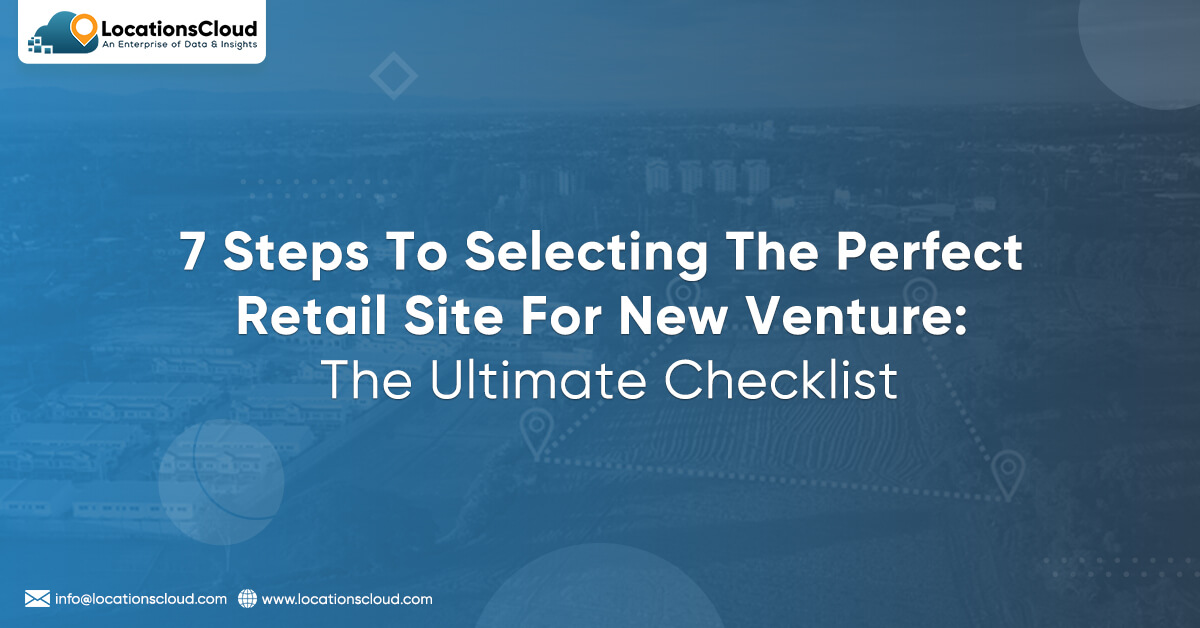
The location of a store can have a significant effect on how well it does. A good site can bring in more customers, make more money, and make a brand more well-known. But finding a new place for a retail store can be challenging, and there are many things to consider to get the best results. The retail site selection checklist that will be given in this blog post goes over the seven most important steps that should be taken when choosing a new spot for a retail business. If retailers follow these steps, they will have a better chance of picking a site that meets their needs and gives them a strong base for growth and success.
Retail site selection is important if you want the ideal location for your retail stores. It can affect how well your business does and, in general, whether or not your business grows. Because a choice like this can have a big effect, using the retail site selection checklist is important. This list helps you remember every part of choosing a store location.
Before you put money into a place to open your store, you must consider how that place will affect your business. Will they make things better or worse? This is one of the most important things you need to think about. So, before we talk about choosing the best spot, it’s important to understand how important this is and how hard it can be.
The importance of selecting the right location for a retail store
Choosing the best location for your retail stores is vital for many reasons leading to the business’s success. Some of the most important reasons why finding the best place is so important are:
Client availability:
A good location ensures the target audience can get to the shop, making it more likely that people will come in. It makes flying much easier and encourages impromptu trips, which brings more people and gives them the chance to buy something.
Target Audience Alignment:
When merchants choose the right site, they can set up shop to fit the likes, needs, and demographics of the market they are trying to reach. Since they can better meet the unique needs of local customers, they have a better chance of making customers happy and keeping them.
Effective positioning:
This can give a business an edge over its competitors. By putting their store next to a competitor or a business that complements their own, merchants can attract customers like them and get more attention and fame in the market.
Image of the Company:
The location of a business store can have a big effect on how people think of its name and image. A smart choice of site in an appealing area can boost the brand’s reputation by giving customers the idea that the brand is reliable, dependable, and appealing.
Long-lasting Development Capacity
Choosing a spot with a chance of long-term growth ensures that the retail store stays open and succeeds. You can find places where there is a chance of constant growth by looking at things like growing populations, changing economic patterns, and expected changes in the area.
The challenges involved in selecting a new location
It takes work to find a new location for your retail stores. It has its own set of unique problems that need to be solved before it can be bought. Retailers should watch out for these typical problems:
Market examination and investigation:
The market must be examined in detail to find good places. This takes time, money, and easy access to correct information. When merchants go into areas that have yet to be explored, it might be hard to get accurate information about the people, buying habits, competition, and changes in the market.
Price factors:
It can be hard to find a mix between the cost of buying or renting a storefront and the expected return on investment. Sites in high demand may have higher rent or purchase costs, which can affect a business’s income, especially if it is small or works independently.
Marketplace Overload and Rivalry:
It’s important to figure out how tough the local market is. To determine if the new spot will be good for business and if there will be any problems, you need to find your closest competitors and look at how full the market is.
Building Criteria:
Following local zoning laws, license requirements, and permission processes can be hard and time-consuming. Businesses need to know how the law works, and they can ensure that the way they plan to use the place is in line with the law.
Facilities and transportation:
It’s important to look at how valuable and good the facilities are. This includes utility systems, driveways, and links to public transit. It can take a lot of work to figure out how easy it is to get to clients or how well the supply chain works, especially in urban or busy places.
Steps for selecting the right location for your retail business
Finding the optimal location for your retail store can be challenging. But here are the steps you need to take to cut down your choices and pick the best one:
Identify Your Audience:
Knowing the target group based on customer preferences and population statistics is important. Also, it is important to know what they want, how they act, and where they live.
Perform market studies:
Gather information about potential areas, such as population data, growth rates, competitive analysis, and customer trends. Find out how interested the local market is in your products and services.
Analyse Competition:
Check to see if there are competitors in each area and how strong they are. Check out the company’s market share, pricing strategy, product line, and amount of customer loyalty. Find any gaps in the market or possible openings that you can use to your benefit.
Think About Easy Access:
Think about how easy it is for the people you want to reach the possible places. Think about how easy it is to get to essential routes and roads. It is whether or not there is public transportation and where you can park.
Cost analysis:
Consider how much each site will cost you. Look at the costs of renting or leasing, the ongoing costs, and the possible return on investment. Compare the prices to the returns and income that are expected.
Site Visits:
The next step is to go to each possible location to evaluate them correctly. Think about things like visibility, foot traffic, nearby businesses, and the vibe of the area as a whole. Think about the house’s condition and any possible downsides or upsides.
Making Calculated Choice:
After you’ve done all these things, you’ll have all the information you need. This will help to make a smart choice. Assess the viability of each site based on who you want to reach. It will depend upon who your competitors are and how convenient it is. Besides, it will depend on how much it costs. Moreover, it will be based on how well it fits your company’s image and goals.
The benefits of choosing retail site selection model
Picking a retail site selection plan is important for many reasons, such as:
Information-Driven Choices:
A commercial location selection strategy helps businesses reach smart conclusions. This is possible by letting them do a thorough study of the data. Companies can rely on information that is not biased if they take into account things like demographics and connections.
Enhanced Site Precision:
A site choice method helps find places that meet the needs and preferences of the target group. Companies can find sites more likely to make money with all the information collected.
Price optimization:
Companies can determine if a place is economically viable by including financial factors in choosing a location. It lets companies choose sites that make the best use of their money and help them make more money.
Competitive Benefits
A good decision plan considers competitors’ presence and strength in different places. Companies can get an edge over their competitors. They can make more money if they find areas where there are fewer competitors.
Tactical Development:
Using a site choice method makes it easier to prepare for store growth. Companies can find a clear way to open new showrooms by comparing different spots to set standards. They can grow their market share, and thus, they can increase their chances of expanding.
Agility and Consistency
A tried-and-true site selection method gives a uniform way to compare and contrast different places. This makes sure that businesses can grow and keep their processes consistent.
Conclusion
Every business owner has to do this at some point, and it can make or break their business. Making a smart choice that will pay off in the long run is essential. It is based on the type of business you’re running, the people you’re trying to reach, and the money you have.


